Do wildlife photographers ‘need to step up’ and do more for conservation efforts? Australian Geographic editor in chief, Chrissie Goldrick, recently pondered just this, asking whether wildlife photographers have a responsibility to ‘communicate grand challenges’, like biodiversity loss and climate change.
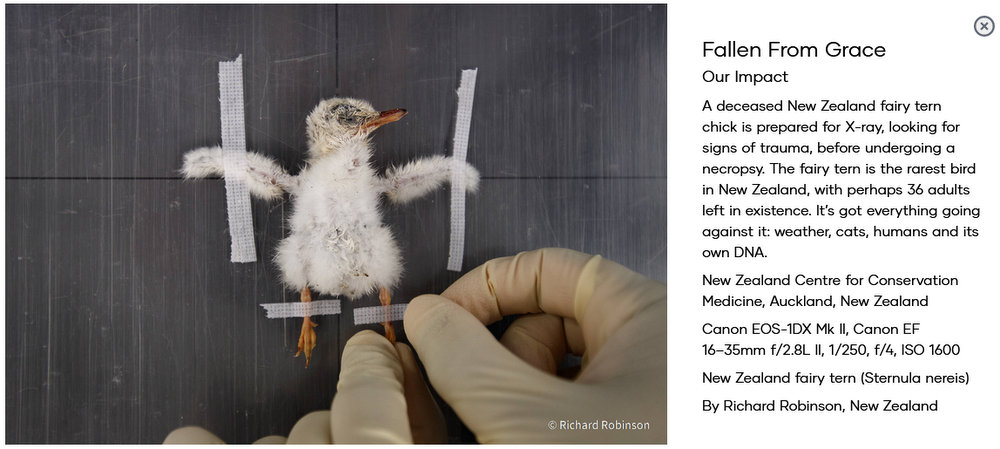
The quotes came from a Sydney Morning Herald article from December 2021 titled, ‘Is it time for photographers to dump the cute and get more political?‘
‘And when we are talking about grand challenges, like the ones we face, like the loss of biodiversity, or climate change, we have to ask ourselves: What responsibility do photographers have to communicate those grand challenges?,’ Chrissie said at an Australian Museum event to commemorate the winners of the 2021 Australian Geographic Nature Photographer of the Year.
‘Still images transcend any kind of cultural or linguistic limitation. It doesn’t matter where you are from, the language you speak that image can speak to you and convey message. A photograph can do many things. It can confront, fortify, and invoke sorrow.’
Chrissie admits not knowing the answer to her question, acknowledging a more confrontational approach may not appeal to Australian Geographic readers. But if anyone is in a position to push for more ‘political’ and ‘confronting’ wildlife photography, it’s the editor-in-chief of Australian Geographic, whose job is to determine what is published in Australia’s leading nature magazine. So it’s telling someone with Chrissie’s credentials cannot say with certainty whether wildlife photographers hold this great responsibility.
‘A typical nature photographer shows a butterfly on a pretty flower, but the conservation photographer shows the same thing with a bulldozer coming out behind,’ she said, pointing out the photo contest finalist exhibition shows both types of images.
It’s an interesting topic to consider given not all wildlife photographers necessarily care for conservation, despite benefiting from the natural world. Plenty of articles and online chatter about standards and guidelines for ‘ethical wildlife photography’ shows there is a dark side of wildlife photography, with some behaving like trophy hunters and forgoing conservation efforts to land a shot. The WA Department of Biodiversity, Conservation and Attractions has even published a basic set of guidelines for wildlife photographers.
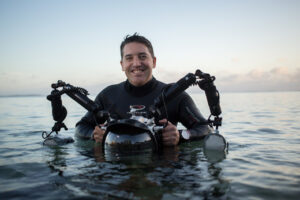
What do wildlife photography conservation efforts look like?
The Herald article was promoting the exhibition for the 2021 Australian Geographic Nature Photographer of the Year photo contest, won by celebrated underwater wildlife photographer, Scott Portelli.
Scott’s wildlife photography happens to focus on conservation, so Inside Imaging touched base to find out more.
‘Conservation is at the forefront of my photography,’ Scott told Inside Imaging. ‘Everything I shoot is to create awareness of a species or the plights they face. As part of the process I contribute a great deal of my photography to science. Whether it is a research initiative or to support those that look after the welfare of animals, my work has been widely used for education and conservation of our natural world.’
His pictures, however, aren’t confronting, like Chrissie previously stated, nor do they ‘invoke sorrow’. Rather than ‘dump the cute’ (take beautiful pictures) to get more political, Scott strikes a balance between the two. He captures captivating wildlife images that regularly win awards, and uses the publicity as an opportunity to educate viewers about his subjects and promote associated conservation efforts.
‘There are many ways to further conservation and working with scientific organisations, researchers or even the government can contribute to the efforts of conservation,’ Scott explained. ‘Creating awareness through media or simply educating our youth can gain momentum. There are so many ways people can get involved and make a difference.’
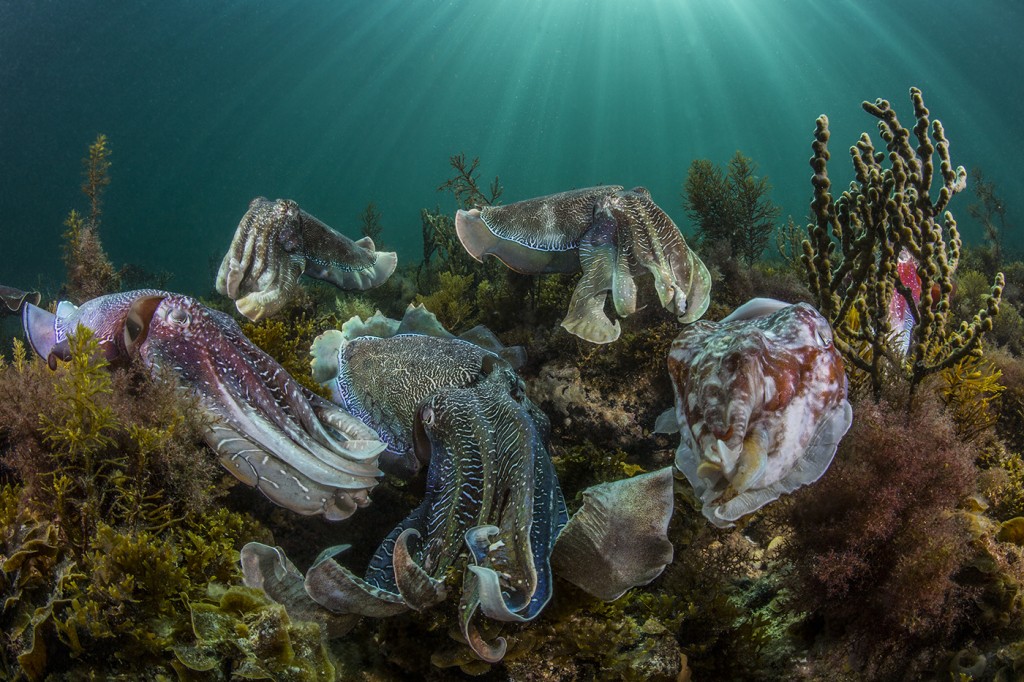
Scott’s ongoing major project on the Australian giant cuttlefish, which began in 2015, is an example of blending conservation efforts with his photography. The cuttlefish are threatened by over fishing from commercial fishermen, with the South Australian government recently lifting a ban on fishing the species in the Spencer Gulf.
Scott visits Whyalla in South Australia to capture the Giant Cuttlefish Aggregation, an annual migration event where thousands gather to breed. ‘These cuttlefish are endemic to South Australia and have a very short life cycle of two years, which means the need to mate in such large numbers ensures the success of generations to come,’ Scott explained
Scott has likely spent more time with the giant cuttlefish than most other wildlife photographers. And for a successful Sydney-based underwater photographer who could easily be tempted by the photogenic colourful warmer regions of Australia, it’s notable Scott’s passion is wildlife endemic to the country’s southern frigid kelp forests.
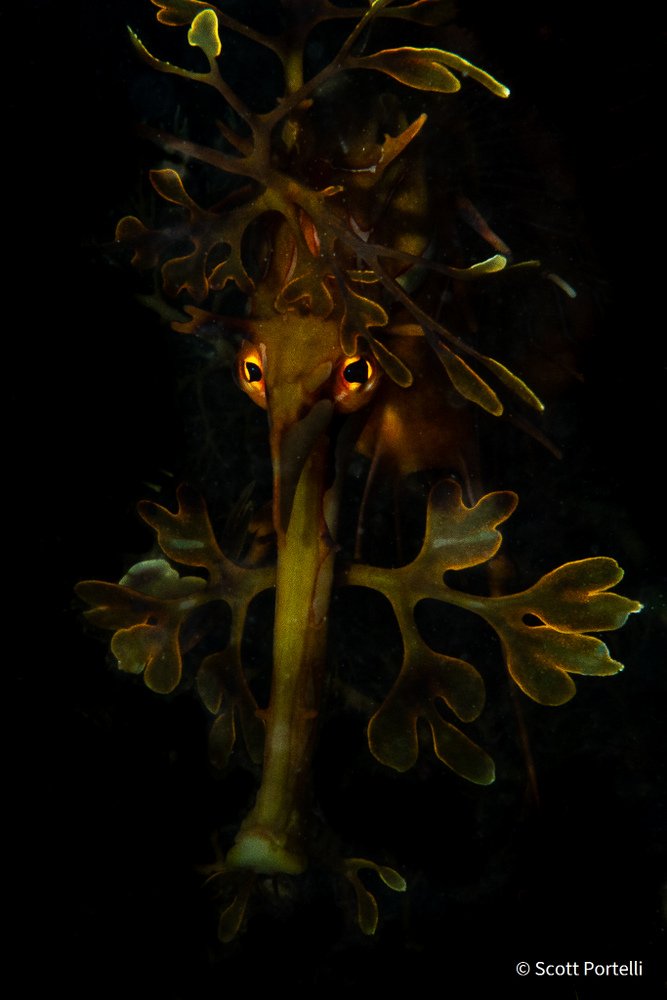
Scott has spoken to several media outlets about cuttlefish, including an article with Adelaide news outlet, InDaily, about over fishing cuttlefish. He is also running a seven-day Cuttlefish and Leafy Seadragon photography workshop, which includes an information session with a marine biologist to educate attendees about their behaviour.
By publishing the photos and educating viewers about cuttlefish behaviour, and pursuing opportunities to weave in information about their plight, Scott shows there is a balance between ‘cute’ and ‘political’. And in return for this work, Scott’s pictures frequently win awards and furthers his career, leading to new assignments and opportunities. It’s a win-win situation for species like the cuttlefish and sea dragon and Scott.
But he’s not drawn strictly to endangered or threatened species. He doesn’t think threatened animals win more photo contests or attract more eyeballs, although more nature photo contests are now including a conservation category. Scott’s most fascinated in animal behaviour, particularly if its interactive, and the sea dragons and cuttlefish tick these boxes.
‘I think if you are a wildlife photographer, you are most likely committed to communicating a message of conservation. Some photographers are passionate about various subjects, while others get into the thick of things will get involved in a cause. But I think most will take on the responsibility.’
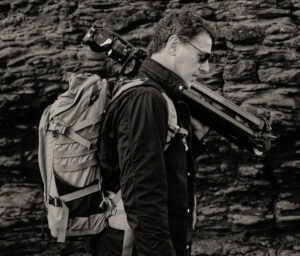
Getting serious about conservation
One photographer who really gets ‘into the thick of things’ is Bangkok-based Australian conservation photojournalist, Adam Oswell.
‘People get into photography for different reasons,’ he told Inside Imaging. ‘Some are motivated by money, recognition, travel, or the lifestyle attached to what they shoot. For conservation, to do it properly the person has to genuinely be passionate about wildlife and conservation, and care about what’s happening to the world.
‘Once somebody is passionate and has that level of interest, they need to do research and look at the issues they care about.’
Oswell left school and travelled to South East Asia, working in the region as a photojournalist in the ’80s and ’90s. He was interested in documenting the rapid industrial and urban developments – issues that led to the destruction of wild and natural environments.
‘The amount of wildlife that was being traded openly that time – it wasn’t really an issue to governments,’ he said. ‘It was shocking for me, so I decided to work on it back then and have been doing it pretty much ever since.’
Oswell has contributed work to the BBC, ABC, The World Conservation Union, The Wildlife Conservation Society, TRAFFIC, WWF International, Humane Society International, the United Nations Development Program, books such as ‘Photographers Against Wildlife Crime‘, and published his own book ‘Black Market-Inside the Endangered Species Trade in Asia‘. He now operates his own Bangkok-based wildlife conservation organisation, Wildlife 1.
He doesn’t describe his work as wildlife or nature photography – it’s more long-term documentary photography. And it scores Chrissie Goldrick’s conservationist trifecta of being ‘confronting, fortifying, and invoking sorrow’, although sometimes there is an overlap with wildlife photography.
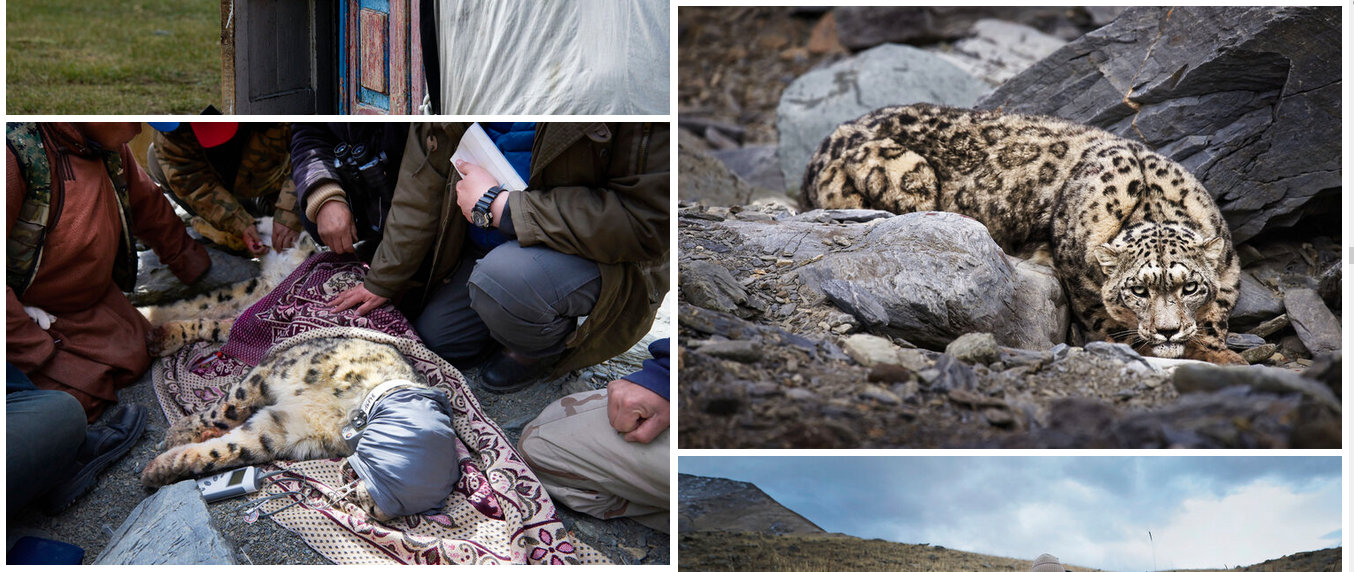
‘I’ve been working for the last five years in Mongolia for an organisation specialising in snow leopard conservation. They work with the local alpine mountain communities. It’s conservation work, but there are lots of opportunities to photograph fantastic wildlife. In terms of being a wildlife photographer or conservationist, they’re quite different.”
He recently won the prestigious UK Natural History Museum Wildlife Photographer of the Year Photojournalism category for his image Elephant in the room. The picture was captured in Thailand, and shows a young elephant underwater in an aquarium pool as an amused crowd watches on.
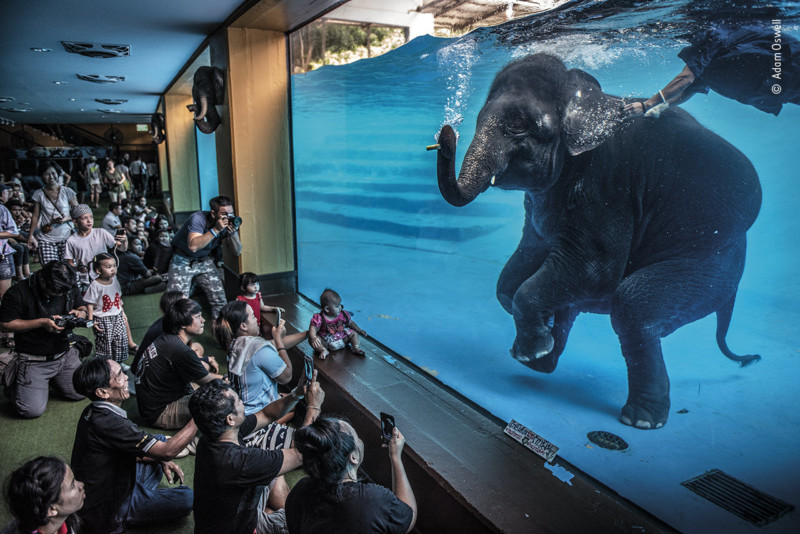
‘That image caused a massive reaction. I never knew how people would react to that, especially here in Thailand,’ Oswell said. ‘It’s such an unusual and shocking image, which says a lot of things. In Thailand they’re very sensitive to criticism, and Thai people see this [domesticating elephants] as being part of their ancient culture.
‘They took it very much as a criticism, and dismissed it as coming from a western perspective. It’s absolute rubbish. It has nothing to do with Thai culture at all. It’s a conservation issue, and is more about the diminishing populations of wild elephants, and other species, because of tourism. The tourism industry has created so much demand for wild elephants, and then so much development has encroached on their habitat and pushed wild elephants to the brink. That’s the issue, really.’
Reflecting on how the contest win furthers conservation efforts, Adam highlights the massive reach leads to global awareness.
‘It makes a broader range of people question things and think. In that sense it’s very powerful. It [his photo] has been in the media everywhere, I’ve been interviewed here and internationally. It’s brought the issue up and gain huge exposure.’
Adam’s work requires more than top quality gear and talent. Strong working relationships and connections with conservation groups and other organisations are critical. ‘Access is really important – it’s really about having those relationships. You can’t just walk into national parks.’
This approach isn’t for everyone. Not everyone wants to photograph the bulldozer behind the butterfly. But as Scott stated earlier, there are many acts that further conservation efforts, and some require very little effort.
Although those who want to get serious with conservation may find it’s a ‘deeply rewarding’ pursuit, says Adam.
‘For any photographer who cares about what is happening to our world right now, I would encourage you to consider animal and conservation photojournalism,’ he told conservation group, We Animals. ‘There are so many critical stories that need to be told right now and those stories can create incredible change. For photographers, it’s a deeply rewarding and fascinating calling to use your skills to speak for the ones who can’t and build meaningful momentum for change and compassion.
‘It’s so important these stories are given the exposure they need and deserve. There’s never been more interest in animal and conservation issues and there are great opportunities right now to tell these stories and expose these critical issues that are going to determine our future. All media have a responsibility and an opportunity to embrace the work of good animal photojournalists. We are all responsible and the choice is ours.’





Be First to Comment